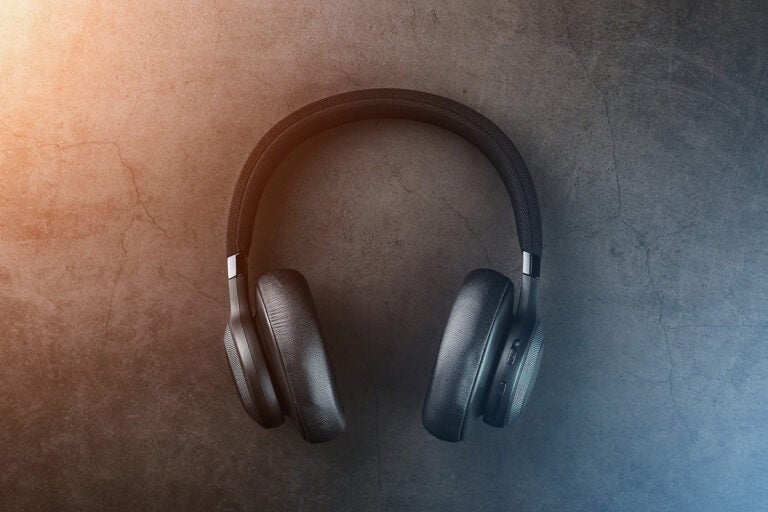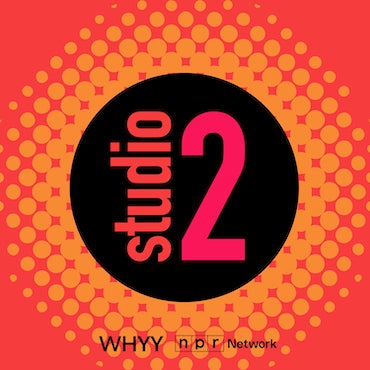Could wearing headphones be damaging your hearing?
Over a billion young people are at risk of hearing loss in part due to headphone use. Audiologists weigh in on the risk, and how to protect your ears.
Listen 13:36
Over a billion young people are at risk of hearing loss in part due to headphone use. (Bigstock/alexgrec)
This story is from The Pulse, a weekly health and science podcast. Subscribe on Apple Podcasts, Spotify, or wherever you get your podcasts.
Listen to the full episode on How Noise Affects Our Health
In 1998, Brian Fligor was a budding audiologist doing his clinical rotation at a hospital in Boston when a 15-year-old boy came in to get his hearing tested after failing a screening at school.
Pretty quickly, Fligor saw the problem— a massive plug of earwax in his right ear.
“And so it was very obvious like, ‘Oh, well, that’s why he didn’t pass,’” Fligor said.
He had the nurses flush out the boy’s ear, and then decided to test him again. As it turned out, the ear that had the plug of wax in it, his right ear, now had perfectly normal hearing. His left ear though, the one without earwax, showed hearing loss consistent with long-term noise exposure.
Fligor was mystified. What he was seeing was the kind of hearing loss he would’ve expected in factory workers who operated noisy equipment, or hunters who spent their weekends around the explosions of gunshots. But this was a 15-year-old kid living in Boston. It had to be something else.
“And so I was asking him, ‘Are you around a lot of high-level sound?’ He was like, ‘What do you mean?’ And I said, ‘Do you listen to music a lot?’ He was like, ‘Well, yeah.’”
Fligor asked how he usually listened to music, and the boy produced a discman with over-ear headphones.
“And I said, ‘Well, how loud do you listen?’ And he said, ‘Well, not all the way up.’”
He showed Fligor on the dial-style volume control, which started at zero and maxed out at 10.
“He had it between nine and 10,” Fligor said. “So he was right, it wasn’t all the way up.”
How loud is too loud?
It was a lightbulb moment for Fligor; somehow, a discman and headphones had caused the same level of hearing damage as years of exposure to dangerously loud machinery. Not only that, but Fligor had just removed the only thing protecting 50% of the kid’s hearing — the earwax plugging up his right ear.
Fligor told his patient that his regular volume setting was “kind of high,” to which the boy answered, “All right, well — if that’s too high, if that’s too loud, how loud can I listen?”
Fligor paused. It was a good question — in fact, it was such a good question that he decided to make it the subject of his PhD dissertation.
To find an answer, Fligor gathered together a bunch of CD players and headphones, and tested them to see how loud they got. He developed his own testing protocol, and then compared his results with safety standards developed by OSHA, or the Occupational Safety and Health Administration, regarding noise levels in workplace settings. His findings?
“All of them had the capacity to be used at too high a level for too long a period of time, such that it would result in risk to someone developing a noise-induced hearing loss from using headphones,” Fligor said.
It’s not just volume, but dosage
Part of what Fligor contributed to the field through his study was the idea of measuring sound according to “dose” — a combination of how loud a sound is and how long you’re exposed to it — as opposed to volume alone. His results varied based on which CD player and headphones he was testing, but overall, he found, it didn’t take much to exceed safe noise dose levels. He finished with an official recommendation: If you’re using a discman with headphones, you should be spending no more than one hour per day listening at 60% volume.
Fligor published his dissertation in a journal called Ear & Hearing in 2004 — six years after that 15-year-old boy first showed up in his office — and to his shock, his study blew up. The public attention wasn’t just due to Fligor being one of the first to investigate this question, but also because, by 2004, the iPod had been released, which meant that way more people than ever before were now listening to music on the go. Of course, Fligor’s study didn’t include the iPod, but that didn’t matter. It had captured the zeitgeist — which meant a lot of media coverage.
His study appeared in newspapers and on the news. He was interviewed for a Rolling Stone article, alongside Pete Townshend from The Who, who blamed his own hearing loss not on his years of live performing, but rather on listening to studio recordings too loud on headphones. And in 2005, Fligor experienced his greatest honor — his study being featured on The Late Show with David Letterman.
“My joke is my career peaked a year after I finished my Ph.D.,” Fligor said, “because, not me but my work, was being spoofed on Letterman.”
So the revolution started by the iPod had elevated Fligor and his research to the national, even the global, stage. In fact, the testing protocol he’d developed for his study ended up being turned into international standards for how to test headphones, and his “sound dosage” concept also gained traction.
Subscribe to The Pulse
How streaming music has changed headphone risk — and research on it
But with the iPod, and the advent of streaming music in general, music files were being processed and compressed in new ways, which reduced the variation of volume levels in any given track.
“Anything that is streamed, it is all almost exactly the same average level, because the range from the softest sound in the music to the loudest sound in the music is actually a really narrow window,” Fligor said. “If you talk to your audio engineers, your audiophiles, your people who are like, ‘Oh, I can’t listen to any streamed music. I need it on a lossless version, so to speak,’ they say, ‘Oh, there’s no dynamics in the music.’”
So streaming music may be a bummer for audiophiles, but good news for our ears — because, even with the volume turned up, you don’t get the kind of sudden spikes of loudness that you used to with CD players. It’s also paved the way for researchers like Fligor to figure out the dosages most people are getting, and how much is safe.
“The result is that it actually makes it really easy for us to measure the sound levels because they’re all really similar,” he said.
The good news is that devices and headphones today aren’t as dangerous as they were back in the ‘90s and before.
“With headphones, the sound level produced by even the old-school CD players were actually a lot louder — the CD players were louder than iPods, iPhones, or Android devices,” Fligor said. “Now, those sounds, they’re actually quite a bit lower. They can be used for a lot longer, so the exposures can be pretty high, but the levels that they produce are not capable of causing an injury after one really loud song you listen to. There would have to be something like a horrible malfunction of a device for it to result in a really high sound exposure, high enough to do damage.”
How loud sounds damage our ears
But that doesn’t mean they’re safe. Remember, it’s not just about volume — it’s about dose; how long you’re listening to something. And damage, just like sun damage to our skin, or the effects of smoking on our lungs, is cumulative.
“So if we live long enough, we’re all going to develop hearing loss,” Fligor said.
A lot of that has to do with the anatomy of our ears.
“The blood flow to our ears is actually not good enough to maintain really good hearing over our entire lifetime,” Fligor said. “That part of the body, the inner ear, is very greedy. It requires a lot of oxygen in order for it to work. It requires, actually, a lot of energy for it to do the job that it does. And it’s so metabolically active, it produces a lot of waste product.”
And that waste product needs to be cleaned up — because, if it isn’t, it can build up, and kill off the sensitive, specialized hair cells that we rely on to hear effectively. The problem, Fligor says, is that given the location and structures of our ears, they don’t get large amounts of blood flow, which makes it difficult for our bodies to clear out that waste product.
“So it’s because of that, that over time, the ear can be overworked,” Fligor said. “If these specialized hair cells die, they’re replaced along that membrane in our inner ear with scar tissue. The scar tissue maintains the whole system, kind of keeps it all together, but it doesn’t contribute to this active process that is hearing. And so, because those hair cells don’t regenerate, they’re not replaced with another hair cell when they die, we lose incrementally hair cells as those are overworked. And so lifetime wear and tear can be accelerated when the ear itself is overworked.”
In other words, it isn’t sound itself that’s blowing out our hearing; rather, it’s the chemical reaction resulting from overwork of the ear that kills off our ears’ hair cells, accomplishing in some cases a lifetime’s worth of wear and tear in just a few months or years.
Headphone-related hearing loss a global threat to young people
Headphone-related hearing loss isn’t a rare phenomenon that only happens to a small percentage of people. In fact, in 2022, a group of researchers working with the World Health Organization released a study looking at potential hearing loss among young people worldwide, resulting from loud concerts or events, and headphone use. Their findings were staggering.
“We’ve showed that about a quarter of young people, 24%, are listening to personal listening devices at a risky level; and about half, or 48%, were regularly attending loud entertainment venues,” said Lauren Dillard, an audiologist and epidemiologist who worked on the study. “So we used these two estimates, alongside the number of the estimate of the global population of individuals aged 12 to 34 years, to estimate that over 1 billion individuals could be at risk for hearing loss from loud sound exposure.”
This wasn’t the first time researchers reached that number. A previous analysis in 2015 by the World Health Organization came to the same conclusion, which led the organization to launch an initiative designed to answer that same question that Brian Fligor’s 15-year-old patient had posed years before: How loud is too loud?
In the 2022 study, Dillard says, they judged “too loud” based on global recommendations of occupational noise exposure limits — which, in this case, was 80 decibels for eight hours a day, 40 hours a week. That’s about as loud as a garbage disposal, or a busy street.
Fligor offered a more detailed answer.
“The best numbers we have say about 8% of people exposed to 85 decibels for eight hours develop hearing loss,” he said. “We know that the lowest level that can still cause hearing loss in some people is actually 75 decibels over the course of eight hours. So it’s this ‘level over time’ thing.”
Meaning, once again, that it’s not just about volume — but about sound dosage, or volume over time. Based on that research, Fligor says, the upper limit of “safe” is 75 decibels.
Measuring how loud your headphones get
So how do you measure how loud your headphones are? Here’s where it gets tricky.
“So … you can’t,” Fligor said. “You cannot accurately measure the sound level of your headphones.”
To be more precise, he added, it is possible, just not for laypeople — at least not without incurring significant costs.
There are, however, two ways that audiologists use to measure headphone volume.
First is a mannequin called KEMAR with microphones for “eardrums,” that costs upwards of $20,000.
Second, is inserting a tiny microphone into someone’s ear canal, playing sound through a pair of headphones, and then analyzing the recording.
“These are two really technical engineering things that, if you want to have that done, I would say go to your audiologist,” Fligor said.
However, he added, there is a DIY way of achieving something similar to the KEMAR mannequin.
“There’s something called a Jolene mannequin where, for probably less than $100, you can build your own headphone measurement device,” Fligor said.
Instructions for building your own Jolene are available here.
What are the best headphones for protecting your hearing?
Over the past decade or so, discussions over which headphones are the safest and riskiest for our ears have bloomed online. That’s led to common misconceptions, like that earbuds are the most dangerous, and bone-conducting or open-backed earphones are the safest.
But, in the end, all that really matters, Fligor says, is the volume being delivered to your ears.
“There’s no evidence to demonstrate that people listen at lower levels if you use a bone conduction headphone, or you use an open-backed, earmuff-style earphone,” he said.
In fact, he added, those kinds of headphone might actually lead to worse listening habits, because they fail to block out competing background noise.
“There is evidence that shows that the background sound level will cause you to turn your volume higher in order to get to your chosen listening level or your preferred listening level,” Fligor said.
In other words, the kind of headphones you use doesn’t especially matter — with the exception of noise-canceling headphones, which can lead people to listening at lower, and therefore safer, levels.
Consumer protection efforts ramp up
So there are limitations to consumers’ ability to track the “sound dose” they’re getting through their headphones on a daily basis — but there have been growing efforts by public health experts, alongside industry, to develop new tools.
In 2019, the World Health Organization released international standards for audio device manufacturers, in an effort to standardize safe listening with help and input from industry players.
“So the standards that have been published earlier, including those focused on devices, have already been both adopted and implemented by a number of industry stakeholders,” researcher Lauren Dillard said. “My impressions are that [industry] people were mostly open and enthusiastic to engage. I think that people recognize the potential risks, and it also provides, I think, a better consumer experience when people have the abilities to make their own decisions regarding how they could protect their hearing.”
A few examples Dillard cited: volume control systems that are more easily accessible, and easier to configure; parental control systems; and a headphone safety mode that reduces the volume once you start hitting the danger zone. More recently, the World Health Organization also released new standards for gaming that include similar measures — like messages to let gamers know when the volume is too loud, or they’re hitting the maximum safe sound dosage for the day.
And that’s just the beginning. Fligor says some people may have noticed that they already get notifications on their smartphones when they’re listening to something too loud — but upcoming safety features, based on WHO standards, should be dropping any day now from major manufacturers.
“It’s going to be released in new operating system updates that say, ‘Hey, you’ve used up about 20% of your total noise dose for today. You’ve got this many more hours you can listen, if you continue listening this way,’” Fligor said. “So all I can say is, stay tuned. The technology exists to inform us how we’re listening. We kind of have to motivate the manufacturers to actually release this stuff. It’s right there — it just needs to be done.”
WHYY is your source for fact-based, in-depth journalism and information. As a nonprofit organization, we rely on financial support from readers like you. Please give today.







